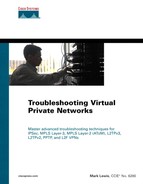Open Systems Interconnection Model
Two reference models are often used to understand internetworking technologies: the Open Systems Interconnection (OSI) and Department of Defense (DoD) models. Both can be useful, but in this book, the model that is used is the OSI model. Figure 1-1 illustrates the OSI reference model.
Figure 1-1. OSI Reference Model

Only four of the seven layers are central to troubleshooting the technologies discussed in this book:
Physical layer (Layer 1)
Data link layer (Layer 2)
Network layer (Layer 3)
Transport layer (Layer 4)
The physical layer is associated with the transmission of bits over the physical medium itself. Characteristics such as voltage levels, maximum transmission distances, and connector types are specified at this layer.
The data link layer handles physical addressing, flow control, access to the physical medium, and error detection. Data link layer protocols include HDLC, PPP, Frame Relay, and Ethernet.
The network layer facilitates the transmission of packets between end systems on different logical networks by providing path determination and selection. Network layer protocols include IP and IPX.
Finally, the transport layer provides end-to-end communication and multiplexing of multiple applications over a transport connection. The transport layer can also provide a reliable channel of communication between end systems, with flow control and congestion avoidance. Transport layer protocols include TCP and UDP.
One thing to remember, however, is that the OSI model is, after all, just a reference model. Not all protocols fit easily; a good example of this is Multiprotocol Label Switching (MPLS). It resides at neither the data link nor the network layer. It sits somewhat uncomfortably between the two.
